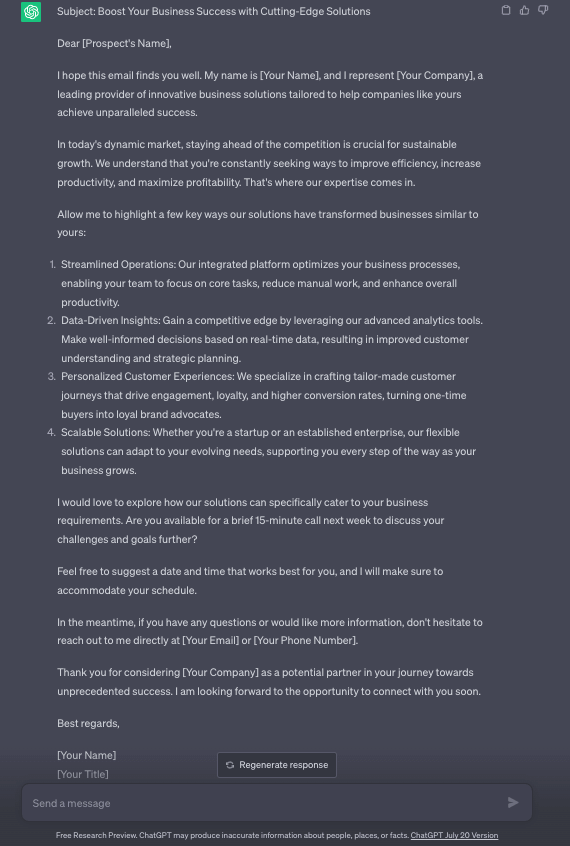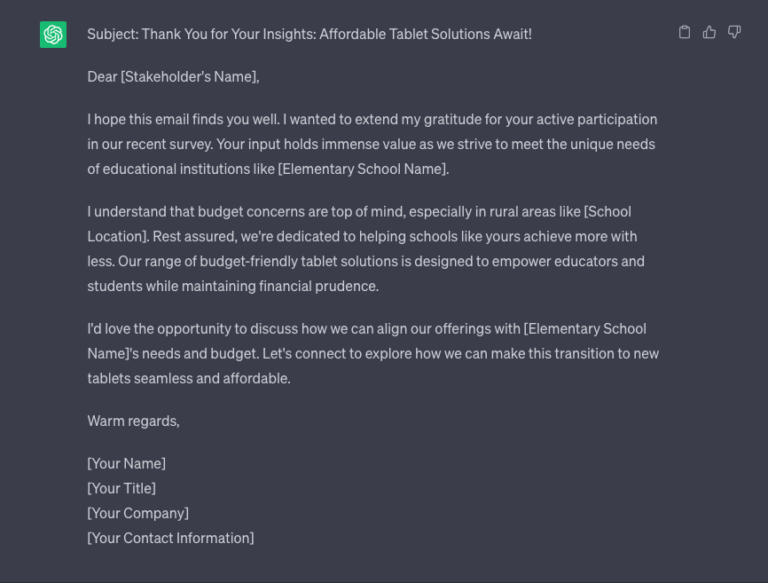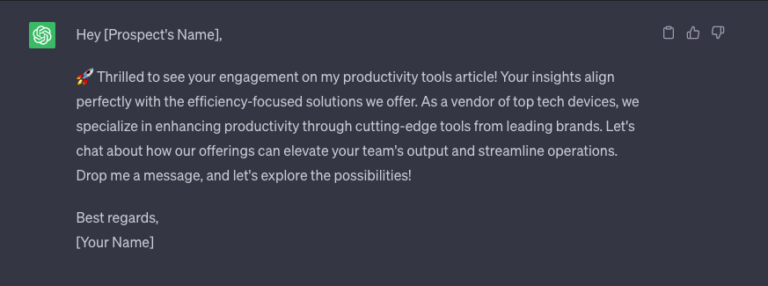Perhaps one of the most profound technological advances in our lifetimes, generative AI has immense potential to revolutionize how people work and create. Its ability to compute, code, and write – among a plethora of other capacities – positions AI as a cost-effective collaborator and assistant across industries.
Above all, generative AI is an efficiency driver. When trained and utilized properly, AI can help you complete many common tasks instantly.
Doing market research? AI can operate as a powerful search engine. Want to make quick changes to your website? AI can code it. Need to write some emails? AI can do that too.
But, it’s not as simple as you may think.
In this article, we explore how to use AI to create sales emails and demonstrate how prompting plays a vital role in generating useful responses.
Getting Started
Before you can start creating sales emails with AI, you need to select a tool.
For this task, you want to use an AI platform powered by a large language model (LLM); colloquially called chatbots, LLMs are AI systems designed to model language, just like an architect would create a model of a building with software.
You’ll probably hear these types of platforms referred to as generative AI. This is a vague term and encapsulates a variety of AI systems, including algorithms that generate images, code, audio, and of course, text.
Here’s a list of the top AI platforms for creating sales emails:
The best part? AI doesn’t have to eat into your bottom line. ChatGPT offers a free version (ChatGPT 3.5) and Bard, still in its experimental phase, is completely free to use.
Disclaimer
In this article I am using ChatGPT, however different AI systems may produce differing results.
For the best results, be descriptive in your prompts. These algorithms are designed to mimic our language, but they don’t actually understand it; be conscientious about the words you select in your prompt as the result will likely restate elements of your input.
Furthermore, generative AI experiences hallucinations, which means the system sometimes responds with fake or false information. Depending on the content of your email, this can be problematic; however, it is simple to circumvent – critically review the response and fact-check all statements or claims.
How to Create Sales Emails with AI
#1. AI prompt for cold sales email
Superficially, you may think all you need to do is ask the AI to “write a cold sales email.” But that approach won’t produce the best results. Take this example.
Prompt: Write a cold sales email to a new lead.

It may be pretty obvious why this didn’t work. For starters, this email is too long for any type of sales email, but especially a cold email.
What’s more, the copy is generic and doesn’t capture any unique value proposition. Value statements aren’t backed up by any proof either – social or data. And, most importantly, the sales email centers the propositioning business’ ‘solution’ and not the recipient’s business and pain points.
Here’s how to start generating better responses:
- Provide the AI with some background information on your business and your target audience/their business.
- Be specific! Define parameters for the AI, such as length, tone, and common industry jargon.
Prompt (refined): Write a 3-paragraph, friendly cold sales email to a new prospect. The prospect is the CFO of a small marketing company that needs improved data storage and retrieval solutions and employee cybersecurity training.

Much better. In this example, the email takes a problem-solution approach. It transmuted the details provided into a more persuasive sales email that places the focus on the prospect, not the prospector.
However, there is still room for improvement.
The response is still too verbose and attempts to sell too soon; cold sales emails should be more inquisitive than transactional. The final paragraph does this well: “I’d love to learn more about your specific challenges…” This is the tone that a cold sales email should possess.
You can continue to refine this email by providing the AI with further instructions. As you continue to train the algorithm, it will start generating better responses immediately.
You can utilize this prompt template to create cold sales emails with AI.
Prompt Template: Write a 3-paragraph, [tone] cold sales email to [prospect details]. They are a stakeholder at [company] which specializes in [services/products]. Their primary pain points are [pain point 1] and [pain point 2].
Cold Email Tips:
- Stop trying to make the sale: Now is not the time, your goal is to get them on a call.
- Don’t bury the lede: Minimize the fluff and indirect statements, get straight to it.
- Do your research: Be professional and show your understanding of their business and needs.
- Avoid clichés: They’re generic and essentially meaningless phrases that take up valuable real estate.
#2. AI prompt for prospecting sales email (warm sales email)
Like cold sales emails, the goal of warm sales emails is to get the recipient on a call. They have already received a touchpoint before, and you’re trying to maintain the line of communication.
However, for a warm lead, you already know that they are (at least somewhat) familiar with your brand, increasing the likelihood that your email will make an impact.
Using generative AI to write prospecting sales emails can be tricky because the model leans toward generating universality rather than individuality – it’s generally ‘general’. But you can overcome this by providing the AI with the specifics.
In this example, a prospect recently completed a survey included in an email campaign. In the survey, they indicated they are a buyer in the education vertical, and that they are struggling with a small budget to equip an outdated elementary school in a rural community with new, high-powered tablets.
Prompt: Write a friendly, 3-paragraph warm sales email to a financial stakeholder for an old elementary school in a rural area that is seeking new tablets but is concerned about budget constraints. Open the email by thanking the contact for engaging with a survey included in an email campaign. Be concise and refer to their budget concerns.

The AI-generated email does a couple things right. First, as prompted, it reminds the prospect of their prior interaction with your brand. Next, it centralizes the stakeholder’s unique circumstances and needs throughout the copy, demonstrating that YOU get it. You understand the struggle of, in this case, being a passionate educator confined by public school budgets, and you’re here to help. This level of insight will magnify the force of all your interactions with a prospect.
But it also does a couple things wrong. It’s fairly wordy, and perhaps even redundant; it could be sharpened down to a finer point. And, overall, the language it uses is a little formal: “extend my gratitude,” for instance. The copy could use some loosening up, and an inclusion of education-specific jargon.
Prompt Template: Write a friendly, 3-paragraph warm sales email to a financial stakeholder at [business/institution] in [relevant context] that is seeking [service/product] but is [pain point]. Open the email by thanking the contact for [previous interaction]. Be concise and refer to their [pain points].
Alternative Prompt Template: Write a friendly, 2-paragraph warm sales email to a financial stakeholder at [business/institution] in [relevant context]. Their key challenges are [pain points] and I want to propose [solution(s)]. Be concise and focus on their [pain points].
Warm Email Tips:
- Behave like an advisor, not a salesperson: Share your expertise and consult your prospect on purchasing choices, rather than try to lock them into a narrow offering.
- Be precise: At this point, you should know some details about their business and challenges – speak to them.
- Reference the previous point of contact: For example, if the recipient downloaded your lead generation asset, refer to it in the opening line of your message. Example: “I hope you enjoyed [asset]. I was curious if it resonated with your business interests?”
- Add personal touches: Create relevancy and rapport through points of mutual interest, business or personal.
#3. AI prompt for LinkedIn Prospecting (LinkedIn Messaging)
LinkedIn is a must-have weapon in the seller’s arsenal. It’s a great tool to build your credibility and create direct connections with new leads; its dynamism is why many salespeople use it to court prospects.
The thing is, constantly writing new pithy and personal sales messages for LinkedIn can be a time suck – especially if social media is ‘not really your thing.’
Maybe your goal is to share an educational asset or provide social proof of the effectiveness of your services, whatever your approach, you can use AI to support the copywriting.
In this example, I wanted to create an informal message to a business owner in my target clientele who recently engaged with my content.
Prompt: Write a 100-word LinkedIn sales message with a pithy greeting to a prospect who engaged with my productivity tools thought leadership article. My business sells devices from popular tech vendors.

This response nailed it. It’s engaging and straightforward. The only edit I would make to this message is replacing “as a vendor of top tech devices,…” to a more precise phrase, such as “as a seller of [vendor]’s devices,…”
However, this response perfectly illustrates how the AI will regurgitate some of the language in your prompt.
Prompt Template: Write a 100-word LinkedIn message with [tone] greeting to a prospect who [behavior/business details]. My business does [details].
LinkedIn Messaging Tips:
- Short and straightforward: The number one rule to be concise while communicating your core message.
- Scope them out: Browse the profile of your prospect to find relevant details that boost your pitch.
- Tailor made: Consider how your services or products could support their specific role-based needs and priorities.
Tips for generating sales emails that convert with AI
#1. Train the bot on your business.
Introduce yourself and your goals to the AI. To get the best results, describe your business in detail. Each chat window should be trained on your business:
- The story of your business
- Primary services and products
- Your vendors and partners
- Industries served/Target clientele
- Location
- Business size
- Other specialties or unique qualities
To get the proper tone, feed the AI your business’ branding guidelines and style notes.
- Examples of marketing materials
- Brand values
- Content pillars
#2. Train the bot on your audience.
To start, each audience segment should have a unique chat window.
The best way to train the bot on a target audience is through information sharing: share details you know already about your audience and ask the bot to elaborate on your points or answer new questions about your target audience.
Research is key to writing sales emails that make a lasting impression. A generic, copy-paste email won’t woo prospects, but emails that demonstrate personal knowledge of their business will. You will create better AI sales emails by providing key audience data points.
Key Audience Points:
- Demographics
- Firmographics
- Pain points
- Purchase history or preferences
- Industry jargon
- Business practices
- Company news
#3. Add the human element
After training the bot, it should provide more personalized sales emails. However, we recommend tweaking the copy the AI provides to make it sound more like yourself and less like a generic sales script.
Quickly review the text for areas you can inject your cadence and word choice into to efficiently tailor the text to your voice and make it sound more human. The best sales emails are the ones that get responses, and personal sales emails are more approachable than dry ones.



